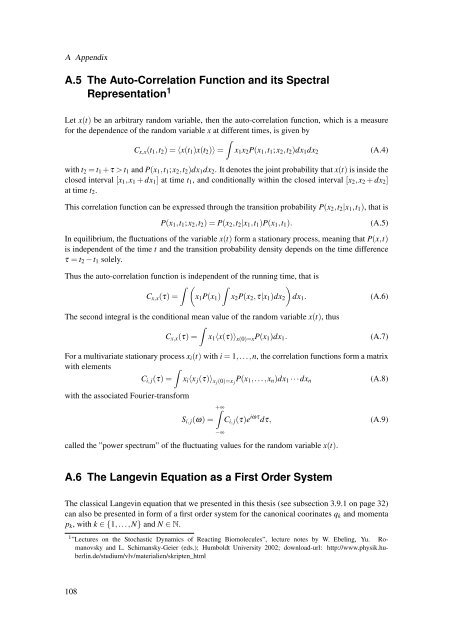Diffusion Processes with Hidden States from ... - FU Berlin, FB MI
Diffusion Processes with Hidden States from ... - FU Berlin, FB MI
Diffusion Processes with Hidden States from ... - FU Berlin, FB MI
You also want an ePaper? Increase the reach of your titles
YUMPU automatically turns print PDFs into web optimized ePapers that Google loves.
A AppendixA.5 The Auto-Correlation Function and its SpectralRepresentation 1Let x(t) be an arbitrary random variable, then the auto-correlation function, which is a measurefor the dependence of the random variable x at different times, is given byˆC x,x (t 1 ,t 2 ) = 〈x(t 1 )x(t 2 )〉 = x 1 x 2 P(x 1 ,t 1 ;x 2 ,t 2 )dx 1 dx 2(A.4)<strong>with</strong> t 2 = t 1 +τ > t 1 and P(x 1 ,t 1 ;x 2 ,t 2 )dx 1 dx 2 . It denotes the joint probability that x(t) is inside theclosed interval [x 1 ,x 1 + dx 1 ] at time t 1 , and conditionally <strong>with</strong>in the closed interval [x 2 ,x 2 + dx 2 ]at time t 2 .This correlation function can be expressed through the transition probability P(x 2 ,t 2 |x 1 ,t 1 ), that isP(x 1 ,t 1 ;x 2 ,t 2 ) = P(x 2 ,t 2 |x 1 ,t 1 )P(x 1 ,t 1 ).(A.5)In equilibrium, the fluctuations of the variable x(t) form a stationary process, meaning that P(x,t)is independent of the time t and the transition probability density depends on the time differenceτ = t 2 −t 1 solely.Thus the auto-correlation function is independent of the running time, that isˆ ( ˆC x,x (τ) = x 1 P(x 1 ) x 2 P(x 2 ,τ|x 1 )dx 2)dx 1 . (A.6)The second integral is the conditional mean value of the random variable x(t), thusˆC x,x (τ) = x 1 〈x(τ)〉 x(0)=x P(x 1 )dx 1 .(A.7)For a multivariate stationary process x i (t) <strong>with</strong> i = 1,...,n, the correlation functions form a matrix<strong>with</strong> elementsˆC i, j (τ) = x i 〈x j (τ)〉 x j (0)=x jP(x 1 ,...,x n )dx 1 ···dx n(A.8)<strong>with</strong> the associated Fourier-transform+∞ ˆS i, j (ω) = C i, j (τ)e iωτ dτ,called the ”power spectrum” of the fluctuating values for the random variable x(t).−∞(A.9)A.6 The Langevin Equation as a First Order SystemThe classical Langevin equation that we presented in this thesis (see subsection 3.9.1 on page 32)can also be presented in form of a first order system for the canonical coorinates q k and momentap k , <strong>with</strong> k ∈ {1,...,N} and N ∈ N.1 ”Lectures on the Stochastic Dynamics of Reacting Biomolecules”, lecture notes by W. Ebeling, Yu. Romanovskyand L. Schimansky-Geier (eds.); Humboldt University 2002; download-url: http://www.physik.huberlin.de/studium/vlv/materialien/skripten_html108









